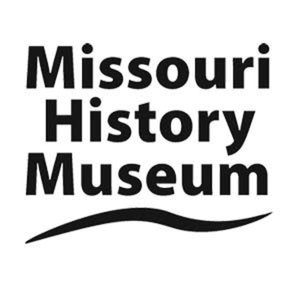from Apr. 17, 1865
M. Winship Note, April 17, 1865
-
Full Title
Note signed M. Winship, Headquarters Provost Marshal General, Defences South of Potomac, Alexandria, Va., to Geo. R. Maguire, Fairfax C.H., April 17, 1865
-
Description
States, "Send him to these Hd Qtrs under guard . . ." Refers to the capture of John Wilkes Booth after the assassination of President Lincoln.
-
Rights
This item is in the public domain.
-
Tags
-
Cite this Item
Winship, M.. "Note signed M. Winship, Headquarters Provost Marshal General, Defences South of Potomac, Alexandria, Va., to Geo. R. Maguire, Fairfax C.H., April 17, 1865". . Remembering Lincoln. Web. Accessed December 13, 2025. https://rememberinglincoln.fords.org/node/639
from Apr. 17, 1865
Note signed M. Winship, Headquarters Provost Marshal General, Defences South of Potomac, Alexandria, Va., to Geo. R. Maguire, Fairfax C.H., April 17, 1865
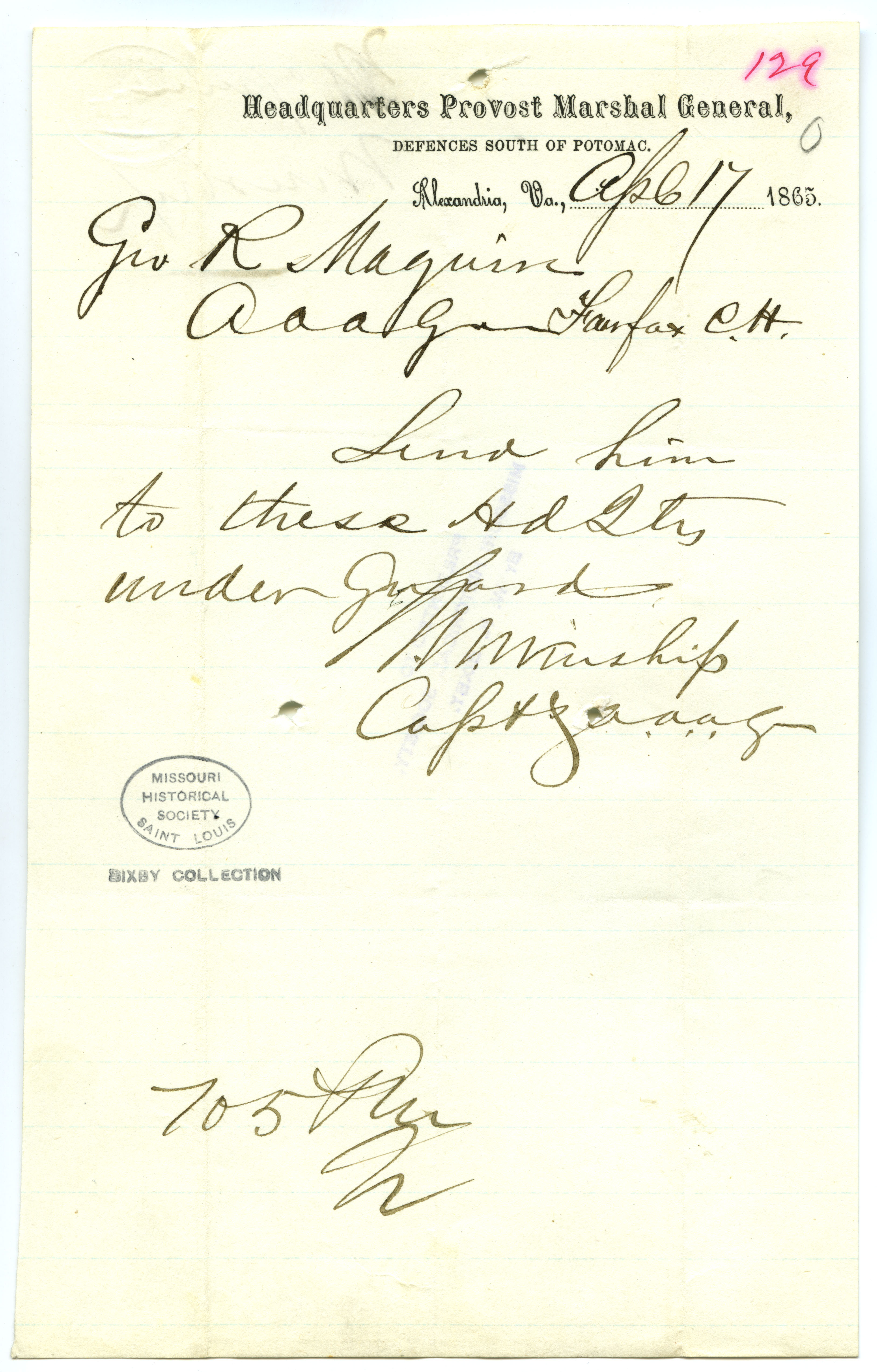
-
Description
States, "Send him to these Hd Qtrs under guard . . ." Refers to the capture of John Wilkes Booth after the assassination of President Lincoln.
-
Rights
This item is in the public domain.
-
Creator
Winship, M.
-
Publisher
-
Date
April 17, 1865
-
Material
from Apr. 17, 1865
Note of J.H. Eldridge, April 17, 1865
-
Full Title
Note signed J.H. Eldridge, U.S.S. "Delaware" off Point Lookout, Md., to Comdr. Parker, St. Inigoes, Md., April 17, 1865
-
Description
States, "Your telegram of this date is received. I will send the Nansemond immediately . . ." Refers to the hunt for John Wilkes Booth after the assassination of President Lincoln.
-
Rights
This item is in the public domain.
-
Tags
-
Cite this Item
Eldridge, J. H.. "Note signed J.H. Eldridge, U.S.S. "Delaware" off Point Lookout, Md., to Comdr. Parker, St. Inigoes, Md., April 17, 1865". . Remembering Lincoln. Web. Accessed December 13, 2025. https://rememberinglincoln.fords.org/node/638
from Apr. 17, 1865
Note signed J.H. Eldridge, U.S.S. "Delaware" off Point Lookout, Md., to Comdr. Parker, St. Inigoes, Md., April 17, 1865
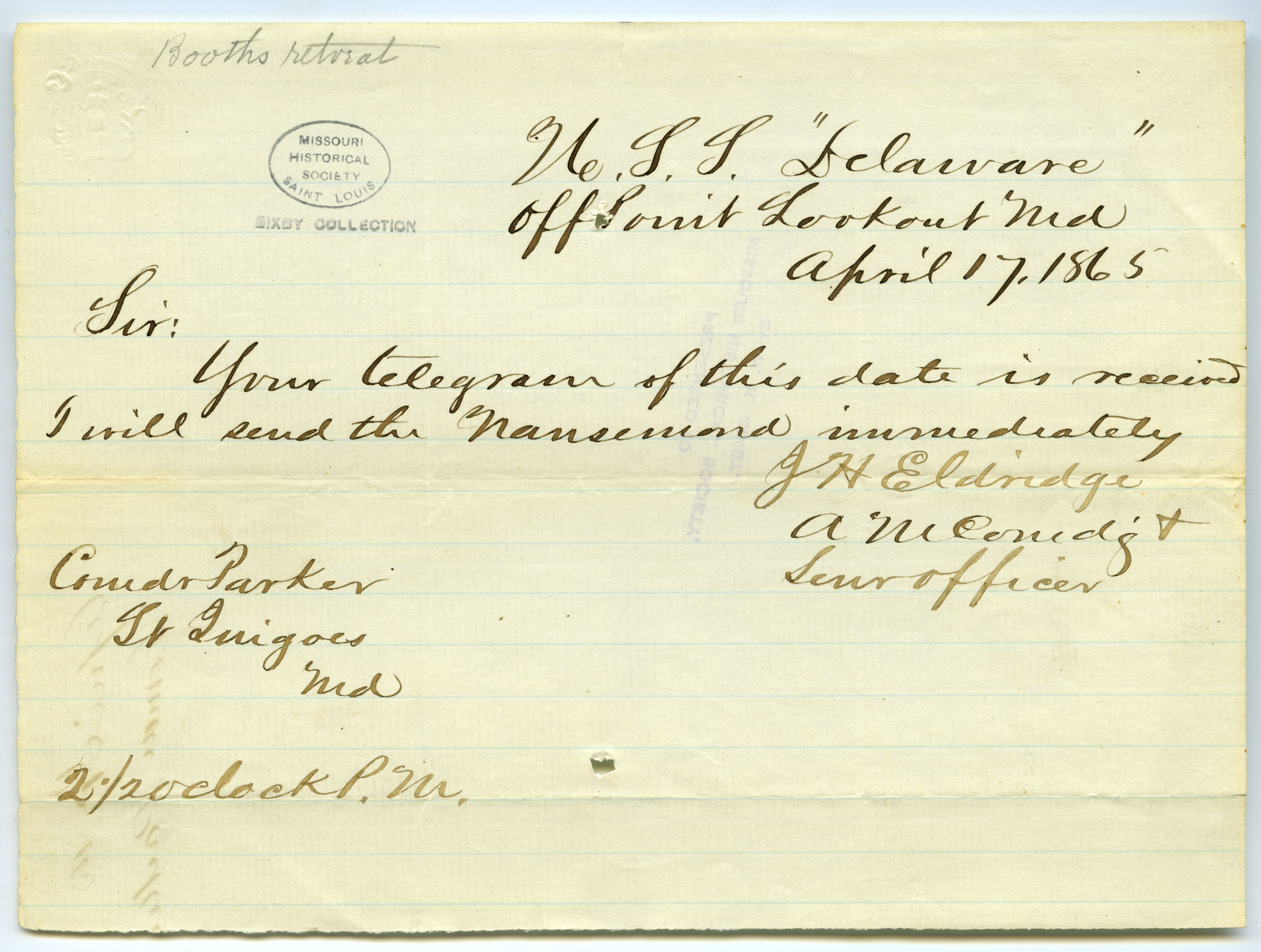
-
Description
States, "Your telegram of this date is received. I will send the Nansemond immediately . . ." Refers to the hunt for John Wilkes Booth after the assassination of President Lincoln.
-
Rights
This item is in the public domain.
-
Creator
Eldridge, J. H.
-
Publisher
-
Date
April 17, 1865
-
Material
from Apr. 17, 1865
Telegram of F.A. Parker, April 17, 1865
-
Full Title
Contemporary copy of telegram of F.A. Parker, Navy Dept., to Senior Naval Officer, Off Pt. Lookout, April 17, 1865
-
Description
States, "Send Nansemond to blockade Patuxent River - without delay. The Murderer has been traced to that River. . . ." Refers to the hunt for John Wilkes Booth after the assassination of President Lincoln.
-
Rights
This item is in the public domain.
-
Tags
-
Cite this Item
Parker, F. A.. "Contemporary copy of telegram of F.A. Parker, Navy Dept., to Senior Naval Officer, Off Pt. Lookout, April 17, 1865". . Remembering Lincoln. Web. Accessed December 13, 2025. https://rememberinglincoln.fords.org/node/637
from Apr. 17, 1865
Contemporary copy of telegram of F.A. Parker, Navy Dept., to Senior Naval Officer, Off Pt. Lookout, April 17, 1865

-
Description
States, "Send Nansemond to blockade Patuxent River - without delay. The Murderer has been traced to that River. . . ." Refers to the hunt for John Wilkes Booth after the assassination of President Lincoln.
-
Rights
This item is in the public domain.
-
Creator
Parker, F. A.
-
Publisher
-
Date
April 17, 1865
-
Material
from Apr. 17, 1865
Military Telegraph of R. O'Brien, April 17, 1865
-
Full Title
United States Military Telegraph of R. O'Brien, Goldsboro, to Genl. Dodge, April 17, 1865
-
Description
States that President Lincoln was assassinated on the night of the 14th while in his box at Ford's Theater. Gives details of the night, including the attack on Seward, and asks that Dodge not make the information public at the present time.
-
Transcription
United States Military Telegraph.
By Telegraph from Goldsboro
Dated April 17, 1865
To Genl. Dodge
Genl,
I regret to have to
tell you that president Lincoln
was assassinated on the night of
14th while in his box at Fords
Theatre. The assassin shot him
through the head and leaped out
of the box brandishing a dagger
and shouting Sic Simfor Tirrannis,
The president lived about 2 hours,
at the same time an assassin
entered Secy Sewards house and stabbed
him several times it is hoped he
will recover but his son Fredrick
was mortally wounded, Do not
make this justice for present.
R. O’Brian
[Transcription Team: Kara C., Avery T., Austin G., Madison R., Tyler S.]
[New Hampton Middle School] -
Rights
This item is in the public domain.
-
Tags
-
Cite this Item
O'Brien, R.. "United States Military Telegraph of R. O'Brien, Goldsboro, to Genl. Dodge, April 17, 1865". . Remembering Lincoln. Web. Accessed December 13, 2025. https://rememberinglincoln.fords.org/node/636
from Apr. 17, 1865
United States Military Telegraph of R. O'Brien, Goldsboro, to Genl. Dodge, April 17, 1865
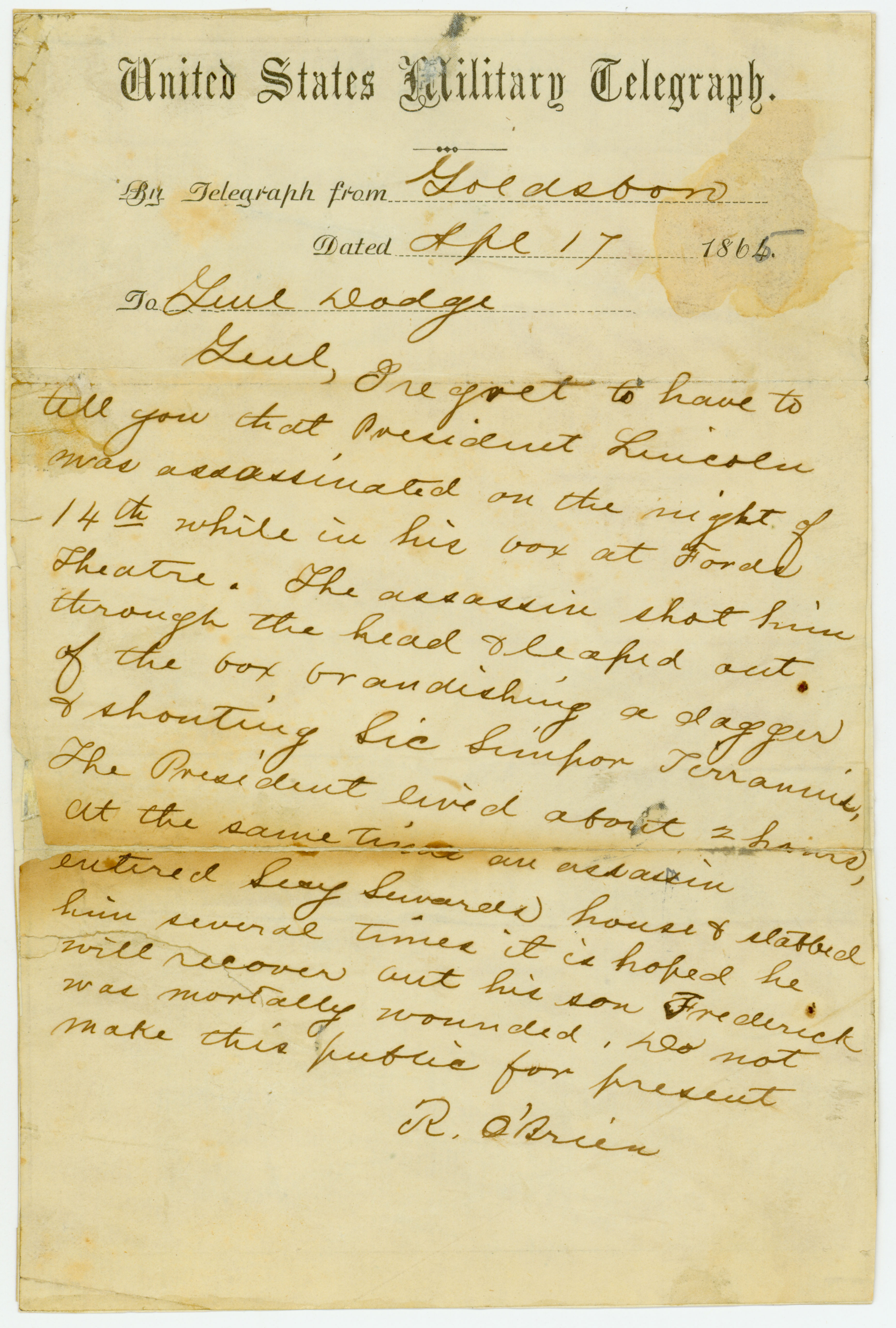
-
Description
States that President Lincoln was assassinated on the night of the 14th while in his box at Ford's Theater. Gives details of the night, including the attack on Seward, and asks that Dodge not make the information public at the present time.
-
Rights
This item is in the public domain.
-
Creator
O'Brien, R.
-
Publisher
-
Date
April 17, 1865
-
Material
from Apr. 17, 1865
J.P. Slough to Lt. Col. J.H. Taylor, April 17, 1865
-
Full Title
Letter signed J.P. Slough, Brig. Genl. Vols., Headquarters Military Governor, Alexandria, Va., to Lt. Col. J.H. Taylor, Chf. of Staff and A.A.G., Hd. Qrs. Dpt. of Washington, April 17, 1865
-
Description
States, "A number of fisherman are tied up at this place. The officir [officer] of the Guard Ship desired to know if the restriction preventing their passing down the River is to be continued or whether he can pass all registered and known persons with their Vessels. . . ." Relates to the hunt for John Wilkes Booth after the assassination of President Abraham Lincoln.
-
Rights
This item is in the public domain.
-
Tags
-
Cite this Item
Slough, John P.. "Letter signed J.P. Slough, Brig. Genl. Vols., Headquarters Military Governor, Alexandria, Va., to Lt. Col. J.H. Taylor, Chf. of Staff and A.A.G., Hd. Qrs. Dpt. of Washington, April 17, 1865". . Remembering Lincoln. Web. Accessed December 13, 2025. https://rememberinglincoln.fords.org/node/635
from Apr. 17, 1865
Letter signed J.P. Slough, Brig. Genl. Vols., Headquarters Military Governor, Alexandria, Va., to Lt. Col. J.H. Taylor, Chf. of Staff and A.A.G., Hd. Qrs. Dpt. of Washington, April 17, 1865
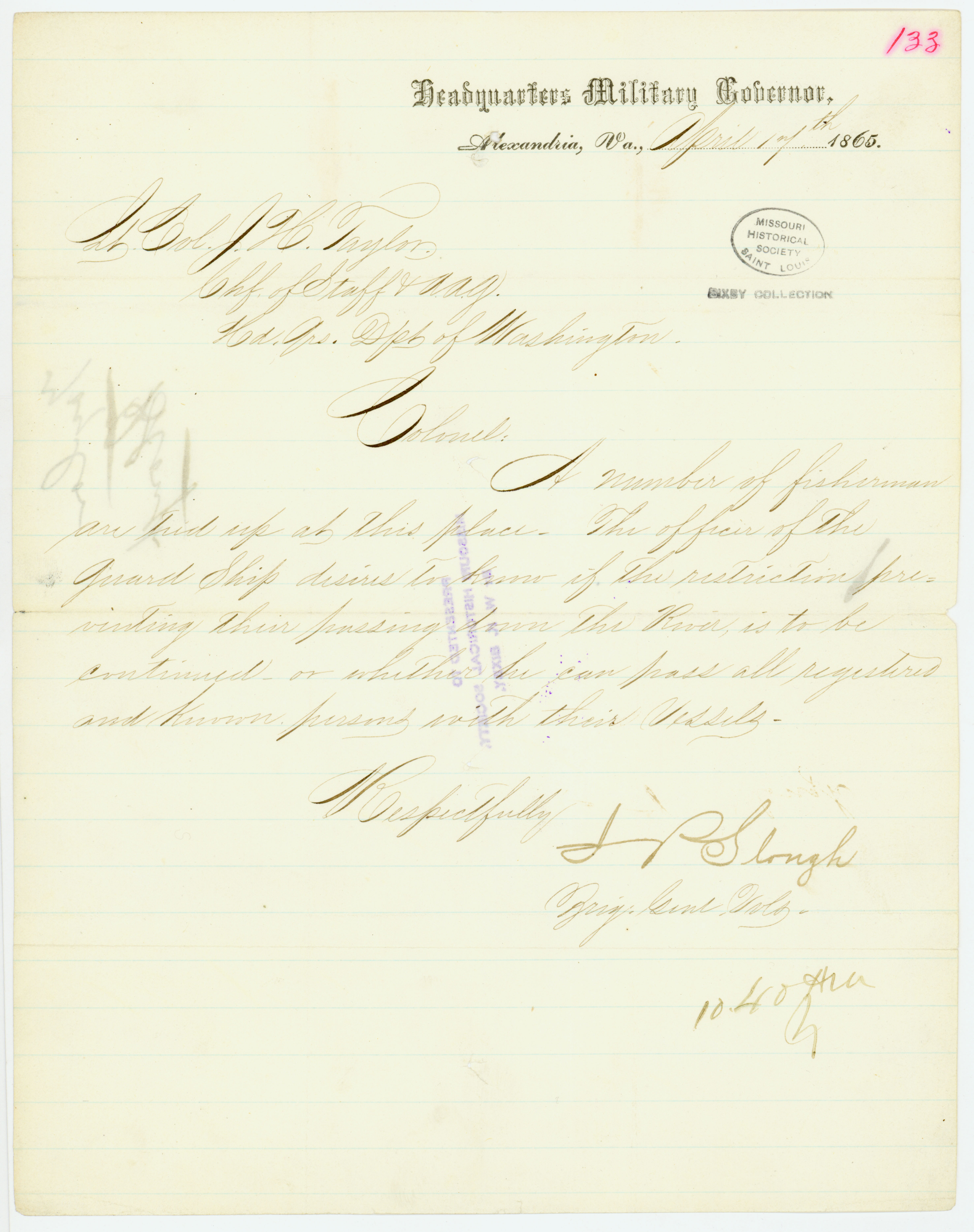
-
Description
States, "A number of fisherman are tied up at this place. The officir [officer] of the Guard Ship desired to know if the restriction preventing their passing down the River is to be continued or whether he can pass all registered and known persons with their Vessels. . . ." Relates to the hunt for John Wilkes Booth after the assassination of President Abraham Lincoln.
-
Rights
This item is in the public domain.
-
Creator
Slough, John P.
-
Publisher
-
Date
April 17, 1865
-
Material
from Apr. 17, 1865
Telegram of F.A. Parker, April 17, 1865
-
Full Title
Telegram of F. A. Parker to Lt. Nickerson, April 17, 1865
-
Description
States, "Every vessel in the Flotilla will fire a gun every half hour the day after the receipt of this order. . . ." Relates to observance of the funeral of President Abraham Lincoln.
-
Rights
This item is in the public domain.
-
Tags
-
Cite this Item
Parker, F. A.. "Telegram of F. A. Parker to Lt. Nickerson, April 17, 1865". . Remembering Lincoln. Web. Accessed December 13, 2025. https://rememberinglincoln.fords.org/node/634
from Apr. 17, 1865
Telegram of F. A. Parker to Lt. Nickerson, April 17, 1865
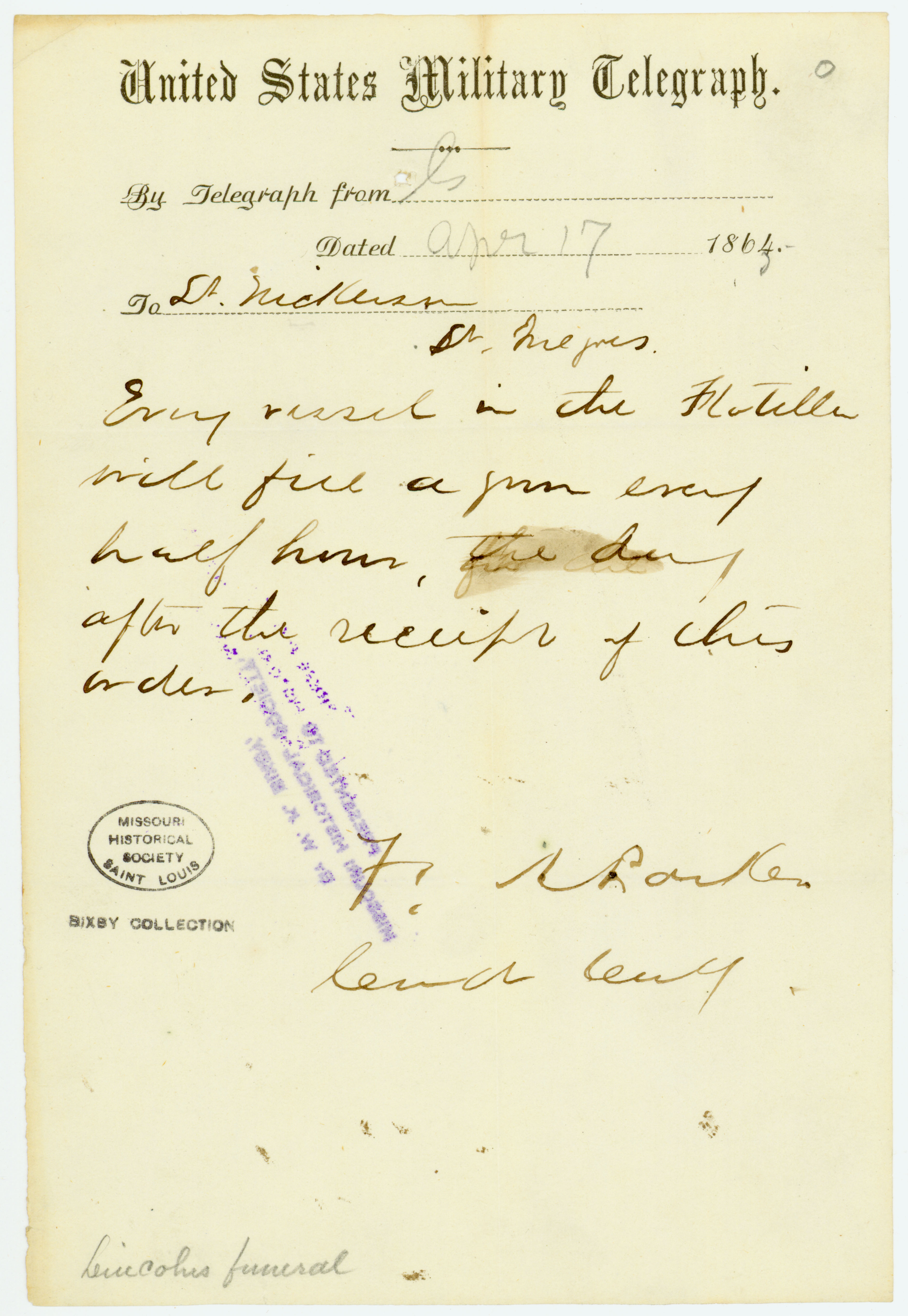
-
Description
States, "Every vessel in the Flotilla will fire a gun every half hour the day after the receipt of this order. . . ." Relates to observance of the funeral of President Abraham Lincoln.
-
Rights
This item is in the public domain.
-
Creator
Parker, F. A.
-
Publisher
-
Date
April 17, 1865
-
Material
from Apr. 16, 1865
The New York Herald, April 16, 1865
-
Full Title
The New York Herald, April 16, 1865
-
Description
The front page of The New York Herald features nearly an entire column of bold headlines on the assassination of President Abraham Lincoln and the attempted assassination of Secretary William Henry Seward. The newspaper prints the dispatches from Secretary of War Edwin M. Stanton to Major General John A. Dix, the statement of witness Clara Harris, physician's notes on Lincoln's failing condition, public reaction to Lincoln's death, the search for the assassins, and the inauguration of Andrew Johnson. Known as "mourning rules," the wide vertical lines between the newspaper columns represent grief over the loss of an important person.
-
Source
HN-1865-011086
-
Rights
Use of this item for research, teaching, and private study is permitted with proper citation and attribution as follows: Courtesy, Newseum Collection. Reproduction of this item for publication, broadcast, or commercial use requires written permission. For permission, please contact the Newseum.
-
Tags
-
Cite this Item
James Gordon Bennett. "The New York Herald, April 16, 1865". James Gordon Bennett. Remembering Lincoln. Web. Accessed December 13, 2025. https://rememberinglincoln.fords.org/node/633
from Apr. 16, 1865
The New York Herald, April 16, 1865
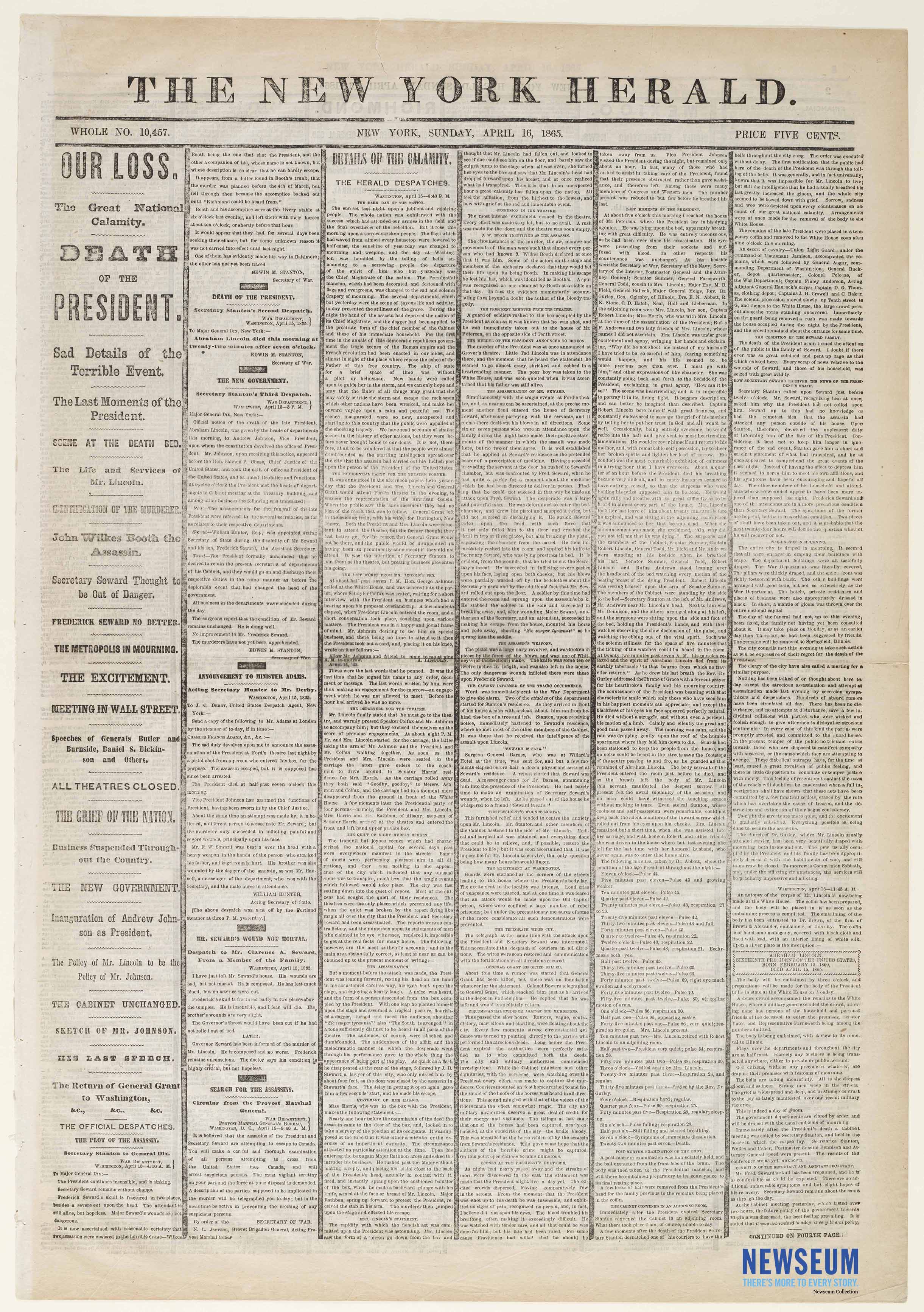
-
Description
The front page of The New York Herald features nearly an entire column of bold headlines on the assassination of President Abraham Lincoln and the attempted assassination of Secretary William Henry Seward. The newspaper prints the dispatches from Secretary of War Edwin M. Stanton to Major General John A. Dix, the statement of witness Clara Harris, physician's notes on Lincoln's failing condition, public reaction to Lincoln's death, the search for the assassins, and the inauguration of Andrew Johnson. Known as "mourning rules," the wide vertical lines between the newspaper columns represent grief over the loss of an important person.
-
Source
HN-1865-011086
-
Rights
Use of this item for research, teaching, and private study is permitted with proper citation and attribution as follows: Courtesy, Newseum Collection. Reproduction of this item for publication, broadcast, or commercial use requires written permission. For permission, please contact the Newseum.
-
Creator
James Gordon Bennett
-
Publisher
James Gordon Bennett
-
Date
April 16, 1865
-
Material
Newspaper
from Apr. 19, 1865
The Daily Progress, April 19, 1865
-
Full Title
The Daily Progress, April 19, 1865
-
Description
The Daily Progress was published in Raleigh, North Carolina, which was occupied by the Union Army at the time this issue was printed. An interior page contains an editorial titled "A National Calamity - the Assassination of President Lincoln" which laments the death of President Abraham Lincoln and encourages citizens of North Carolina to pledge their allegiance to the Union. The paper also prints a dispatch from Secretary of War Edwin M. Stanton to Major General W.T. Sherman relaying the news of Lincoln's death, as well as Sherman's Special Field Order No. 50 relaying the same. Known as "mourning rules," the wide vertical lines between the newspaper columns represent grief over the loss of an important person.
-
Source
HN-1865-011098B
-
Rights
Use of this item for research, teaching, and private study is permitted with proper citation and attribution as follows: Courtesy, Newseum Collection. Reproduction of this item for publication, broadcast, or commercial use requires written permission. For permission, please contact the Newseum.
-
Tags
-
Cite this Item
J.L. Pennington & Co.. "The Daily Progress, April 19, 1865". . Remembering Lincoln. Web. Accessed December 13, 2025. https://rememberinglincoln.fords.org/node/632
from Apr. 19, 1865
The Daily Progress, April 19, 1865
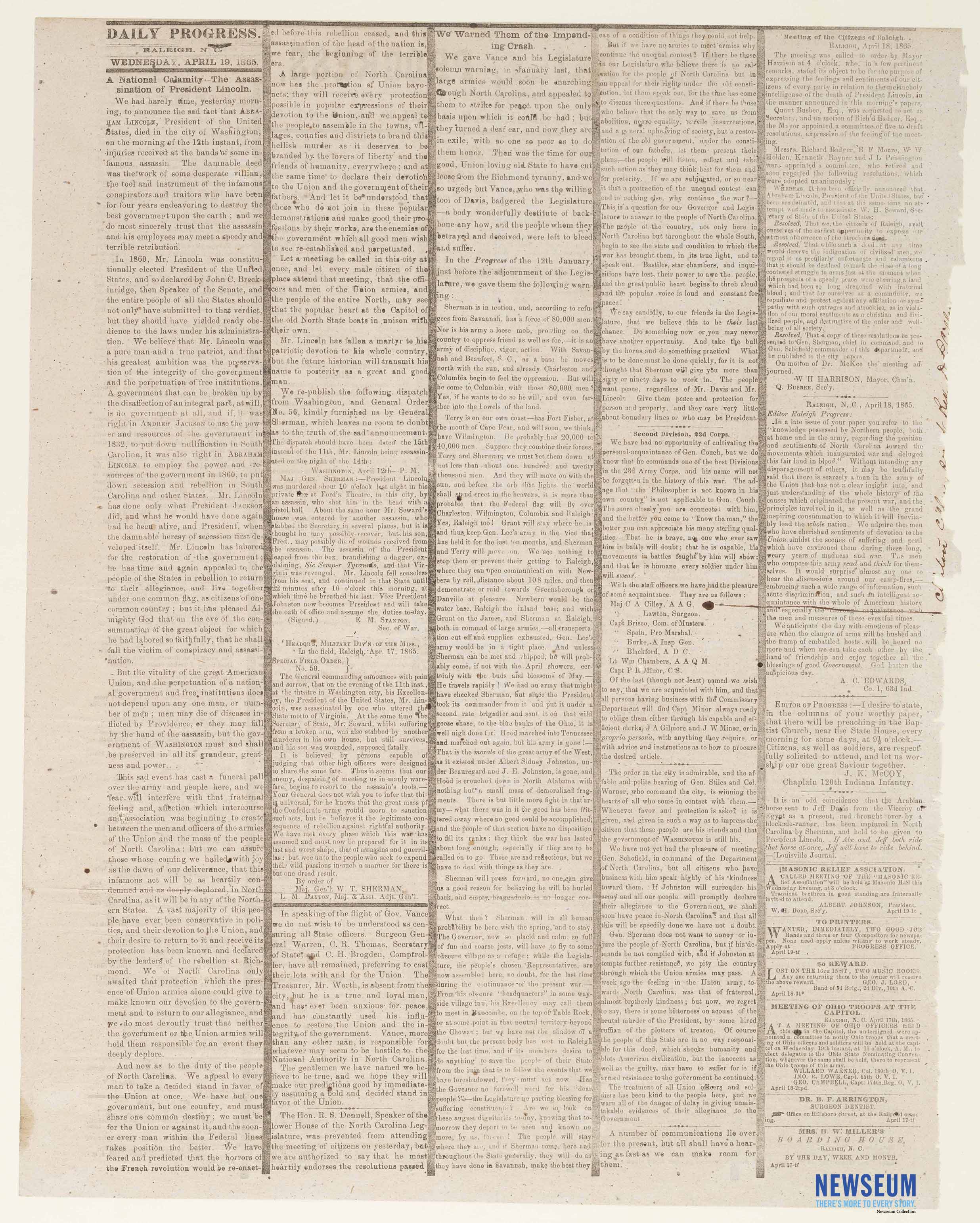
-
Description
The Daily Progress was published in Raleigh, North Carolina, which was occupied by the Union Army at the time this issue was printed. An interior page contains an editorial titled "A National Calamity - the Assassination of President Lincoln" which laments the death of President Abraham Lincoln and encourages citizens of North Carolina to pledge their allegiance to the Union. The paper also prints a dispatch from Secretary of War Edwin M. Stanton to Major General W.T. Sherman relaying the news of Lincoln's death, as well as Sherman's Special Field Order No. 50 relaying the same. Known as "mourning rules," the wide vertical lines between the newspaper columns represent grief over the loss of an important person.
-
Source
HN-1865-011098B
-
Rights
Use of this item for research, teaching, and private study is permitted with proper citation and attribution as follows: Courtesy, Newseum Collection. Reproduction of this item for publication, broadcast, or commercial use requires written permission. For permission, please contact the Newseum.
-
Creator
J.L. Pennington & Co.
-
Publisher
-
Date
April 19, 1865
-
Material
Newspaper
from Apr. 15, 1865
Baltimore Clipper, April 15, 1865
-
Full Title
Baltimore Clipper, April 15, 1865
-
Description
The Baltimore Clipper newspaper provides extensive details on the assassination of President Abraham Lincoln and the attempted assassination of Secretary William Henry Seward. It contains numerous official dispatches from Secretary of War Edwin M. Stanton to Major General John A. Dix about Lincoln's condition. Known as "mourning rules," the wide vertical lines between the newspaper columns represent grief over the loss of an important person.
-
Source
HN-1865-011058
-
Rights
Use of this item for research, teaching, and private study is permitted with proper citation and attribution as follows: Courtesy, Newseum Collection. Reproduction of this item for publication, broadcast, or commercial use requires written permission. For permission, please contact the Newseum.
-
Tags
-
Cite this Item
Bull & Tuttle. "Baltimore Clipper, April 15, 1865". Bull & Tuttle. Remembering Lincoln. Web. Accessed December 13, 2025. https://rememberinglincoln.fords.org/node/631
from Apr. 15, 1865
Baltimore Clipper, April 15, 1865
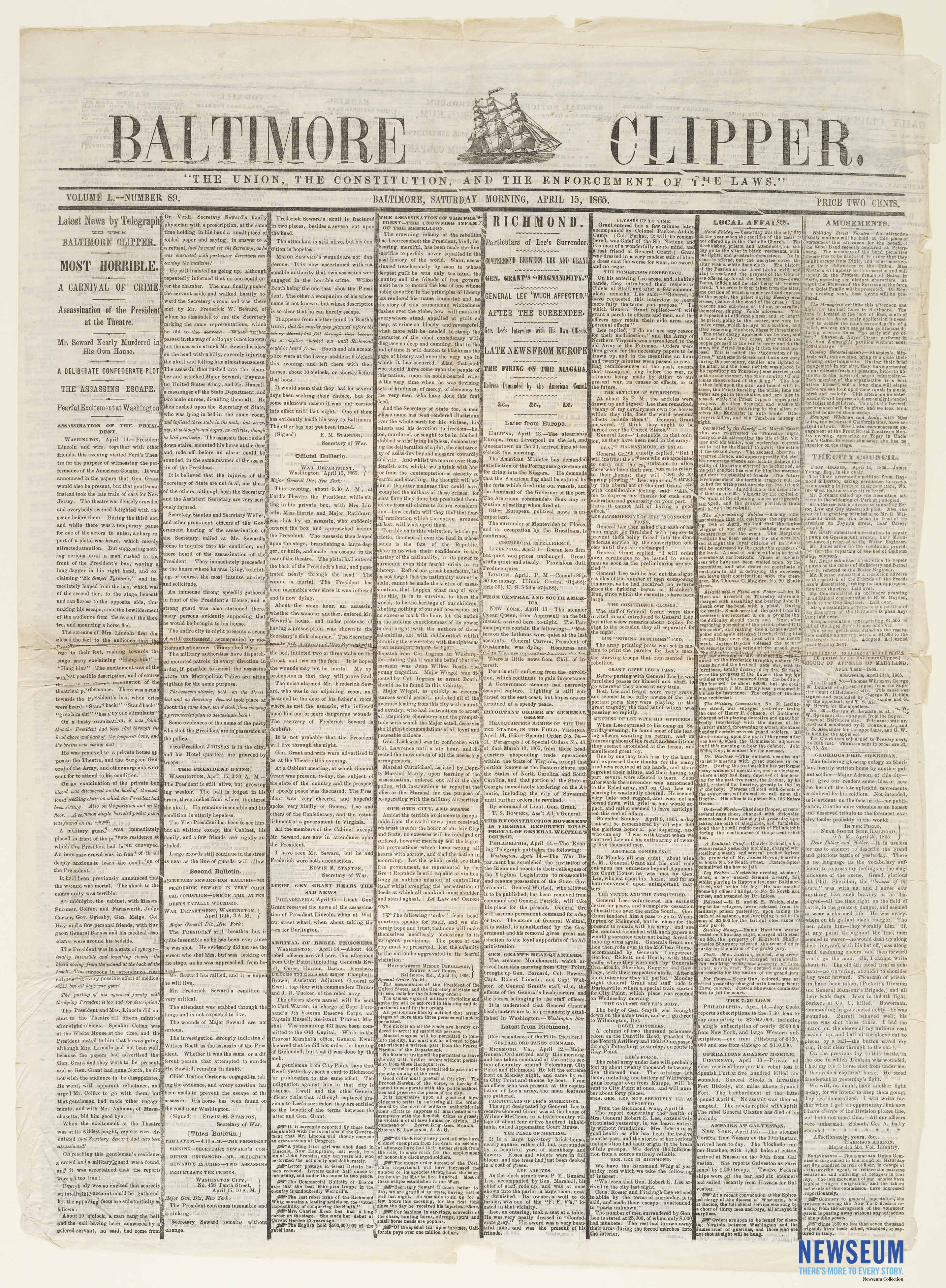
-
Description
The Baltimore Clipper newspaper provides extensive details on the assassination of President Abraham Lincoln and the attempted assassination of Secretary William Henry Seward. It contains numerous official dispatches from Secretary of War Edwin M. Stanton to Major General John A. Dix about Lincoln's condition. Known as "mourning rules," the wide vertical lines between the newspaper columns represent grief over the loss of an important person.
-
Source
HN-1865-011058
-
Rights
Use of this item for research, teaching, and private study is permitted with proper citation and attribution as follows: Courtesy, Newseum Collection. Reproduction of this item for publication, broadcast, or commercial use requires written permission. For permission, please contact the Newseum.
-
Creator
Bull & Tuttle
-
Publisher
Bull & Tuttle
-
Date
April 15, 1865
-
Material
Newspaper
from Apr. 21, 1865
The Liberator, April 21, 1865
-
Full Title
The Liberator, April 21, 1865
-
Description
William Lloyd Garrison's abolitionist newspaper provides extensive details on the assassination of President Abraham Lincoln and the attempted assassination of Secretary William Henry Seward. It contains the 1:30 a.m. official dispatch from Secretary of War Edwin M. Stanton to Major General John A. Dix, as well as the 8:00 a.m. dispatch reporting Lincoln's death. Known as "mourning rules," the wide vertical lines between the newspaper columns represent grief over the loss of an important person.
-
Source
HN-1865-011108B
-
Rights
Use of this item for research, teaching, and private study is permitted with proper citation and attribution as follows: Courtesy, Newseum Collection. Reproduction of this item for publication, broadcast, or commercial use requires written permission. For permission, please contact us at artifacts@newseum.org.
-
Tags
-
Cite this Item
Wm. Lloyd Garrison. "The Liberator, April 21, 1865". Wm. Lloyd Garrison. Remembering Lincoln. Web. Accessed December 13, 2025. https://rememberinglincoln.fords.org/node/630
from Apr. 21, 1865
The Liberator, April 21, 1865
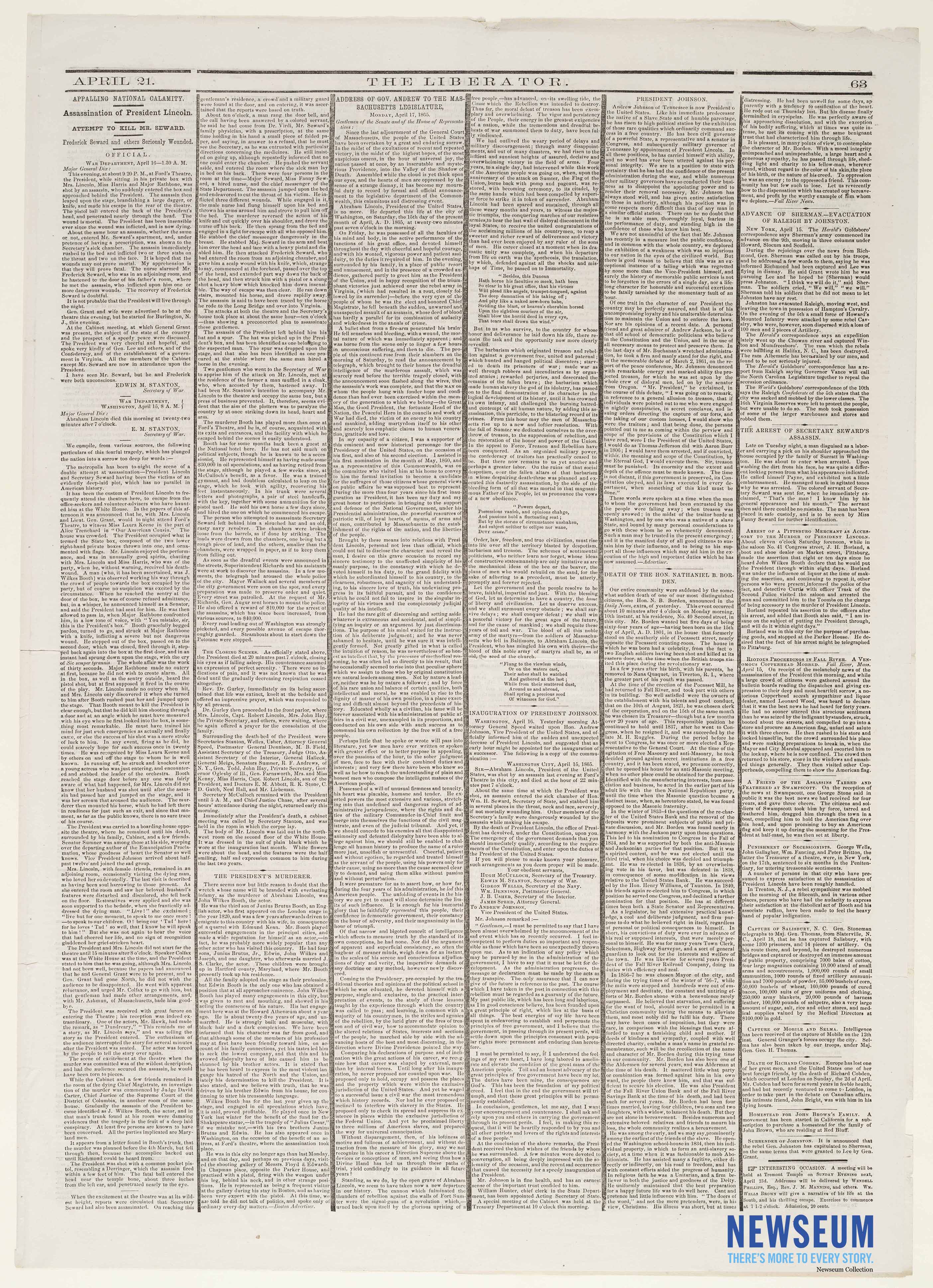
-
Description
William Lloyd Garrison's abolitionist newspaper provides extensive details on the assassination of President Abraham Lincoln and the attempted assassination of Secretary William Henry Seward. It contains the 1:30 a.m. official dispatch from Secretary of War Edwin M. Stanton to Major General John A. Dix, as well as the 8:00 a.m. dispatch reporting Lincoln's death. Known as "mourning rules," the wide vertical lines between the newspaper columns represent grief over the loss of an important person.
-
Source
HN-1865-011108B
-
Rights
Use of this item for research, teaching, and private study is permitted with proper citation and attribution as follows: Courtesy, Newseum Collection. Reproduction of this item for publication, broadcast, or commercial use requires written permission. For permission, please contact us at artifacts@newseum.org.
-
Creator
Wm. Lloyd Garrison
-
Publisher
Wm. Lloyd Garrison
-
Date
April 21, 1865
-
Material
Newspaper
